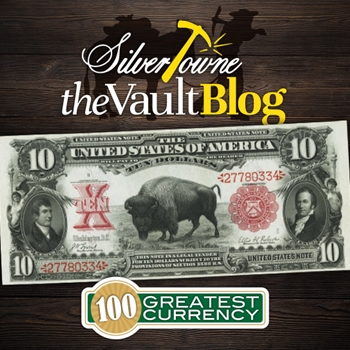
Navigating our way back into the top ten of the 100 Greatest American Currency Notes as compiled by Whitman Publishing, we take a look this time around at a collector favorite. With help from authors Q. David Bowers and David M. Sundman, our focus will be on a single example of a note that was made over a long period of time until its eventual replacement took over.
#6 - Popular Western Motif $10 Legal Tender “Bison Note,” Series of 1901
With nine different Treasury signature combinations of the Series of 1901 $10 Legal Tender Note, there is just one single note the collectors go after the most. Known as the Bison Note, or the Buffalo Bill, many were made over a long period of time. The face of the popular note features portraits of explorers Meriwether Lewis and William Clark on either side with a bison at the center. Regardless of the reality of the situation with Native Americans at the time, the American West themes were popular in art and entertainment. Themes including cowboys, “Indians” (actors that dressed in costume), longhorn cattle, bison robes and other trappings were used in touring shows to depict the “Wild West”. Other Indian depictions were being used on coinage and certificates already.
The Series 1901 $10 Legal Tender Bison Note featured a sketch by Charles Knight that depicted a bison named Pablo from the Washington Zoo. It was engraved by M.S. Baldwin. More specifically, the bison on the note was referenced as National Zoological Park Bison No. 2926 as it arrived at the zoo in late October of 1897. It was purchased for $500 from Michael Pablo who was a Montana rancher. It died on October 3, 1914.
This particular example is said to have an estimated number of 3,000 to 4,500. In 1960, the historic market value of the note in Gem Crisp Uncirculated condition was estimated to be $55. By this publication in 2006, that same note was valued at $6,000.







